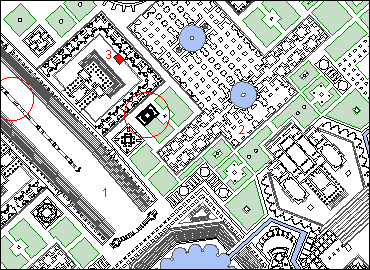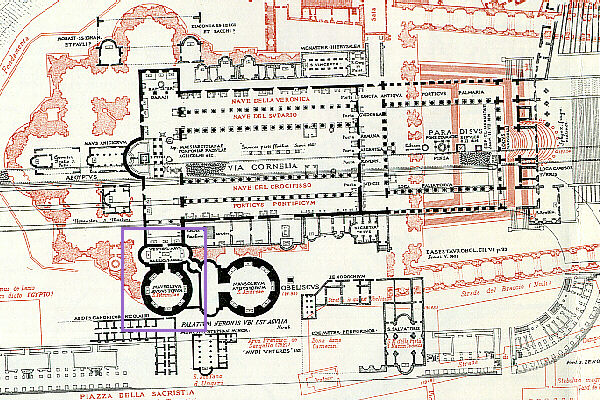Sep. Honorij Imp.
1998.07.17
The Sepulchrum Honorij Imp. represents the last building of ancient Rome within the Ichnographia Campi Martii. Honorius was indeed Rome's last imperial patron in terms of major building projects, and Piranesi's concluding with the Tomb of Honorius suggests that an objective for the Ichnographia was to display the total imperial building history of the Campus Martius and its environs. This possible objective, however, remains ambiguous because Piranesi blatantly omits some major architectural monuments such as the Aurelian Wall and Constantine's Basilica of St. Peter. Nonetheless, the Tomb of Honorius marks the Ichnographia's temporal end limit against which all interpretations of Piranesi's objectives must be calibrated.

| |

Sepulchrum Honorij Imp.
Designed as a square void within a circular solid within a rectangular void created by a wall, the Sepulchrum Honorij Imp. exhibits a composition of simple geometric shapes, which is a common trait of all Piranesi's sepulcher typology.
Sepulchrum Honorij Imp. in context:
The Tomb of Honorius is situated between the Circus Caij et Neronis (1) and the Porticus Neronianae (2). The actual site of the tomb or mausoleum (indicated by the second red circle) was along what at one time was the spina of the Circus of Caligula and Nero. The Sepulchr. Mariae Honorij Congiig. (3) -- the tomb of Honorius' first wife Maria -- is close by.
|
Delineated as a stand-alone building within the Horti Neroniani, Piranesi situates the tomb close to its actual site, which was beside and attached to the south transept of the original St. Peter's Basilica. Although St. Peter's is absent from the Ichnographia, the tomb's real site is locatable because it was built along the spina of the Circus of Caligula and Nero, which is placed correctly within the Ichnographia albeit unlabeled [in the second state of the Ichnographia]. Even without St. Peter's, the Tomb of Honorius is still next to a basilica shaped building, which Piranesi labels Porticus Neronianae, and turning the tomb in conjunction with the porticus upside-down discloses an even closer representation of the tomb's true locale. Given this set of circumstances, it is not hard to imagine that Piranesi is here attempting to deliver a message, namely that the beginning of the fifth century, when Honorius built his mausoleum, was the time when the political situation in Rome itself began to completely turn around.
| |
Catalogo reference:
Sepolcro d'Onorio Augusto «Paolo Diac. nel lib. 14 del suppl. ad Eutrop.»
|
The Real Mausoleum of Honorius
Honorius built his mausoleum c.400 for himself and his family. It attached directly to the south transept of St. Peter's Basilica, and was next to a pagan aristocratic tomb of the third century. The practice of attaching burial mausolea-chapels to major shrines was not unusual during late antiquity and early medieval times. In the middle of the eighth century, Popes Stephen II (752-7) and Paul I (757-67) took over the Mausoleum of Honorius, and converted it into the church of St. Petronilla. During the sixteenth century, the mausoleum, along with the original St. Peter's, was destroyed to make way for the present basilica.
 The Mausoleum of Honorius shown in relation the original St. Peter's, the present St. Peter's, and the Circus of Caligula and Nero. From Lanciani's Forma Urbis Romanae.
The Mausoleum of Honorius shown in relation the original St. Peter's, the present St. Peter's, and the Circus of Caligula and Nero. From Lanciani's Forma Urbis Romanae.
|
| |
Honorius, Flavius
1998.07.17
- son of the emperor Theodosius I, and brother of Arcadius
- the first emperor of the western Roman empire
The emperor Honorius plays a significant role within the narrative of the Ichnographia in that his sepulcher is the last building of ancient Rome represented in the large plan. With the exception of the Arch of Arcadius, Honorius and Theodosius (which is not represented within the Ichnographia), all of Honorius' other building activities in Rome involved repairs to existing structures. Indeed, Honorius is the last Roman emporer to build imperial structures in Rome.
In broad terms, the reign of Honorius signifies the Roman Empire's cessation as a cohesive whole, as well as Rome's ceasing to be the nucleus of classical civilization. Furthermore, Honorius' new constructions in Rome denote a clear shift in focus directed away from the Roman Forum and aimed at the Basilica of St. Peter in the Vatican valley--a shift that reflects perfectly Rome's inversion from paganism to Christianity.
Sep. Mariae Honorij Congiig.
1998.08.01
The Sepulchrum Mariae Honorij Congiig., the tomb of Empress Maria the first wife of Honorius, is the second to last building of ancient Rome designated within the Ichnographia Campus Martius. Piranesi mistakenly represents the tomb of Maria as separate from the tomb of Honorius; Maria's death may well have been the reason Honorius erected his family mausoleum around 400. Despite Piranesi's incorrectness, the position of Maria's tomb on the large plan falls within the area of the Vatican Hill that is actually occupied by St. Peter's Basilica, thus adding some veracity to the sepulcher's location. Moreover, Maria's tomb is within a courtyard surrounded on three sides by what appear to be other sepulchers whose placement within the Ichnographia partially coincides with the necropolis still in existence under St. Peter's Basilica, which is the traditionally held burial place of St. Peter himself. Another interesting detail is Piranesi's placement of Maria's tomb directly in front of the Templum Apollonis that is attached to the Circus of Caligula and Nero. According to "The Life of Sylvester" within the Liber Pontificalis, the original St. Peter's Basilica was built "in the shrine of Apollo," thus indicating that Piranesi's placement of the sepulcher of Maria within the Ichnographia was not altogether incorrect, but rather subtly and cleverly making note of the ancient Rome's pagan to Christian inversion.
|